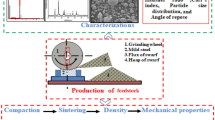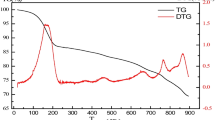Abstract
Ore morphology plays a vital role during the milling and liberation of minerals. This study was carried out to understand the role of mineral crystallography and mineral interfaces on the milling and liberation processes. Data related to mineral crystallography, Vickers Hardness Number and beneficiation processes were collected from literature, and detailed statistical analysis was conducted to relate these parameters. Review of the crystallographic information of minerals present in ores indicates that molecular weight and cell parameters significantly affect milling and liberation characteristics. Mineral interfaces were classified into the three categories of coherent crystals, semi-coherent and incoherent crystals, and breakage behaviors were studied. The studied cases revealed that these material interfaces control the micropore properties that play a vital role in the initiation of intergranular and intercrystalline fractures which occur in siliceous manganese ores and dolomite as a result of thermal treatment. In contrast, banded hematite jasper and coal exhibited a much more complex fracture pattern due to their coherent interfaces and finer physical associations. This study explains the effect of the various types of interfaces on milling, and the approach can be helpful in developing a methodology to enhance mineral liberation with minimum energy consumption.
Similar content being viewed by others
References
Bauer, S.J. and Johnson, B., 1979, “Effects of slow uniform heating on the physical properties of the Westerly and Charcoal granites,” Proceedings of the 20th U.S. Symposium on Rock Mechanics Austin, Texas, pp. 7–18.
Bearman, R.A., Briggs, C.A., and Kojovic, T., 1997, “The applications of rock mechanics parameters to the prediction of comminution behavior” Minerals Engineering, Vol. 10, No. 3, pp. 255–264.
Blazy, P., Zarogatsky, L.P., Jdid, E.A., and Hamdadou, M., 1994, “Vibroinertial comminution — principles and performance,” International Journal of Mineral Processing, Vol. 41, No. 1–2, pp. 33–51.
Bradt, R.C., Lin, C.L., Miller, J.D., and Chi, G., 1995, “Interfacial fracture of multiphase particles and its influence on liberation phenomena” Minerals Engineering, Vol. 8, No. 4–5, pp. 359–366.
Broek, D., 1982, Elementary Engineering Fracture Mechanics, 3rd ed., Martinus Nijhoff Publishers, The Hague, Netherlands, pp. 10–14.
Griffen, Dana T. and Johnson, Brad T., 1984, “Strain in triclinic alkali feldspars: a crystal structure study,” American Mineralogist, Vol. 69, pp. 1072–1077.
Friedman, M. and Johnson, B., 1978, “Thermal cracks in unconfined Sioux quartzite,” Proceedings of the 19th U.S. Symposium on Rock Mechanics Reno, Nevada, pp. 423–430.
Goble, Ronald J. and Scott, Steven D., 1985, “Relationship between mineral hardness and compressibility,” Canadian Mineralogist, Vol. 23.2, pp. 273–85.
Griffith, A. A., 1921, “The Phenomenon of Rupture and Flow in Solids” Phil. Trans. Roy. Soc. A, Vol. 221, pp. 163–197.
Heins, W.A., 1995, “The use of mineral interfaces in sand-sized rock fragments to infer ancient climate,” Geological Society of America Bulletin, Vol. 107, pp. 113–125.
Craig, James R. and Vaughan, David J., 1981, Ore Microscopy and Ore Petrography, Wiley & Sons, New York, pp. 108–140.
Johnson, B., Gangi, A.F., and Handin, J., 1978, “Thermal cracking of rock subjected to slow, uniform temperature changes” Proceedings of the 19th U.S. Symposium on Rock Mechanics Reno, Nevada, pp. 259–267.
Klimpel, R.R. and Austin, L.G., 1982, “Chemical additives for wet grinding of minerals” Powder Technology, Vol. 31, No. 2, pp. 239–253.
Kranz, R. L., 1983, “Microcracks in rocks: A review” Tectonophysics, Vol. 100, No. 1–3, pp. 449–480.
Kumar, P., Sahoo, B.K., De, S., Kar, D.D., Chakraborty, S., and Meikap, B.C., 2010, “Iron ore grindability improvement by microwave pre-treatment” Journal of Industrial and Engineering Chemistry, Vol. 16, No. 5, pp. 805–812.
Laubrach, S.E., Marrett, R.A., Olson, J.E., and Scott, A.R., 1998, “Characteristics and origins of coal cleat: A review,” International Journal of Coal Geology, Vol. 35, pp. 175–207.
Lehr, J.R. and McClellan, G.H., 1974, “Cento-Symposium on the Mining and Beneficiation of Fertilizer Minerals” Ankara, Central Treaty, Organization Public relations division, Turkey, pp 194–242.
Lytle, J., Choi, N., and Prisbrey, K., 1992, “Influence of Preheating on Grindability of Coal,” International Journal of Mineral Processing, Vol. 36, pp. 107–112.
Malcolm, G., Mario, M., Javier, T., and Susana, T., 2012, “A correlation between Vickers Hardness indentation values and the Bond Work Index for the grinding of brittle minerals” Powder Technology, Vol. 224, pp. 217–222.
Manuel, P. and Raja Singh, I., 2011, “Minimum metric dimension of silicate networks,” Ars Combinatoria, Vol. 98, pp. 501–510.
Norgate, T.E. and Weller, K.R., 1994, “Selection and operation of high pressure grinding rolls circuits for minimum energy consumption,” Minerals Engineering, Vol. 7, No. 10, pp. 1253–1267.
Plendl, Johannes N. and Gielisse, Peter J., 1965, “Hardness of Nonmetallic Solids on an Atomic Basis,” Physical Review, Vol. 125, No. 3, pp. 828–832.
Singh, V., Tathavadkar, V., Denys, M.B., and Venugopal R., 2012, “Application of quartz inversion phenomenon in mineral processing-A case study of siliceous manganese ores,” Minerals Engineering, Vol. 32, pp. 8–11.
Sirdeshmukh, D.B., Sirdeshmukh, L., Subhadra, K.G., Rao, K. K., and Bal Laxman, S., 2001, “Systematic hardness measurements on some rare earth garnet crystals,” Bulletin Material Science, Vol. 24, pp. 469.
Suszynska, M., Grau, P., Szmida, M., and Nowak-Wozny, D., 1997, “Correlated studies of Vickers hardness and the yield stress of NaCl crystals doped with Ni2+, Ca2+ and Eu2+,” Material Science and Engineering A, Vol. 234–236, pp. 747–750.
Tavares, L.M., 2000, “Role of particle microstructure in comminution” Proceedings of the XIX International Mineral Processing Congress Rome, Vol. C, C4–99 to C4–106.
Tavares, L.M. and das Neves, Patricia B., 2008, “Microstructure of quarry rocks and relationships to particle breakage and crushing,” International Journal of Mineral Processing, Vol. 87, No. 1–2, pp. 28–41.
Sprunt, E. and Brace, W.F., 1974, “Some permanent structural changes in rock due to pressure and temperature,” Proceedings of the 3rd Congress of International Society of Rock Mechanics, Vol. II-A, pp. 524–529.
US Department of Energy, Energy Efficiency and Renewable Energy (DOE), 2005, “Mining Industry of the Future Fiscal Year 2004,” Annual Report, Industrial Technologies Program.
Users Manual. X’Pert High Score v. 2.2a, PANalytical B.V., 2006.
Uytenbogaart, W. and Burke, E.I., 1971, Tables for Microscopic Identification of Ore Minerals Princeton Univ. Press, 1971, pp. 3–10.
Wang, E., Shi, F., and Manlapig, E., 2011, “Pre-weakening of mineral ores by high voltage pulses,” Minerals Engineering, Vol. 24, No. 5, pp. 455–462.
Weitao, Y., Parr, Robert G., and Uytterhoeven, L., 1987, “New relation between hardness and compressibility of minerals” Physics and Chemistry of Minerals pp. 191–195.
Wills, B.A., 1992, Mineral processing technology: An introduction to the practical aspects of ore treatment and mineral recovery 5th ed., Pergamon Press, Oxford, p. 109.
Author information
Authors and Affiliations
Corresponding author
Additional information
Paper number MMP-13-073.
Discussion of this peer-reviewed and approved paper is invited and must be submitted to SME Publications Dept. prior to May 31, 2015.
Rights and permissions
About this article
Cite this article
Singh, V., Venugopal, R., Banerjee, P.K. et al. Effect of morphology on breakage and liberation characteristics of minerals and coal. Mining, Metallurgy & Exploration 31, 186–192 (2014). https://doi.org/10.1007/BF03402469
Received:
Accepted:
Published:
Issue Date:
DOI: https://doi.org/10.1007/BF03402469




